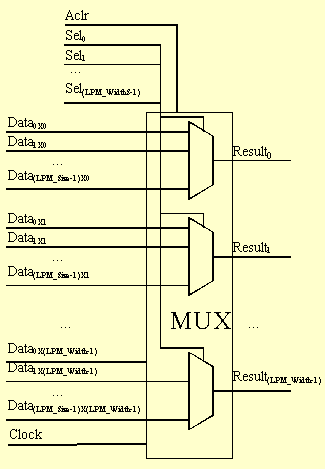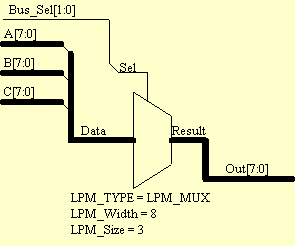![]()
Copyright © 1998 University of Manchester
|
|
|
4.2.7 LPM_MUX |
|
Copyright © 1998 University of Manchester |

| Description | Comments | |||
| Data input | Vector, LPM_Size times LPM_Width wide | |||
| Selected input vector | Vector, LPM_Width wide | |||
| Selects one of the input vectors | Vector, LPM_WidthS wide | |||
| Clock for pipelined usage | Note 1 | |||
| Asynchronous Clear | Note 2 |
Note 1: The clock port provides for pipelined operation of the LPM_MUX. If a latency other 0 (default value) is specified, then the clock port must be connected.
Note 2: The pipelined initializes to undefined. The Aclr port
may be used at any time to reset the pipeline to all 0's asynchronously
to clock.
| Value | Comments | ||
| LPM Value > 0 | Width of output vector. Number of Multiplexers. | ||
| LPM Value > 0 | Number of inputs to each Multiplexer. Number of input buses. | ||
| LPM Value > 0 | WidthS should be the next integer greater than or equal to log2(LPM_Size) or there will be unselectable input vectors. | ||
| LPM Value > = 0 | Default is 0 - non-pipelined |
| | ||
This table assumes that LPM_Size is a power of two, but that is
not required. If there is no Data vector that corresponds
to the 'Sel Value'; that is, if DataSel_Value
is not connected or is greater than LPM_Size, the selection of
'Sel Value' will produce an undefined Result.
Suppose the designers have three 8-bit buses and they want to
select one of the three buses. This is done using an LPM_MUX with
an LPM_Width of 8 and an LPM_Size of three. The LPM_Width of eight
indicates that there are eight multiplexers, and the LPM_Size
of three indicates that each multiplexer has three inputs.

Supposing that bus A becomes Data2Xi, bus B becomes Data1Xi, and bus C becomes Data0Xi, the function performed by the LPM_MUX gate in this case is:
Out[1] = Result1 = DataSelX1 = (UNDEFINED if Sel = 3, A[1] if Sel = 2, B[1] if Sel = 1, C[1] if Sel = 0 )
Out[2] = Result2 = DataSelX2 = (UNDEFINED if Sel = 3, A[2] if Sel = 2, B[2] if Sel = 1, C[2] if Sel = 0 )
Out[3] = Result3 = DataSelX3 = (UNDEFINED if Sel = 3, A[3] if Sel = 2, B[3] if Sel = 1, C[3] if Sel = 0 )
Out[4] = Result4 = DataSelX4 = (UNDEFINED if Sel = 3, A[4] if Sel = 2, B[4] if Sel = 1, C[4] if Sel = 0 )
Out[5] = Result5 = DataSelX5 = (UNDEFINED if Sel = 3, A[5] if Sel = 2, B[5] if Sel = 1, C[5] if Sel = 0 )
Out[6] = Result6 = DataSelX6 = (UNDEFINED if Sel = 3, A[6] if Sel = 2, B[6] if Sel = 1, C[6] if Sel = 0 )
Out[7] = Result7 = DataSelX7 = (UNDEFINED if Sel = 3, A[7] if Sel = 2, B[7] if Sel = 1, C[7] if Sel = 0 )
|
Copyright © 1998 University of Manchester |